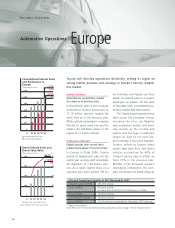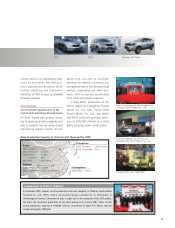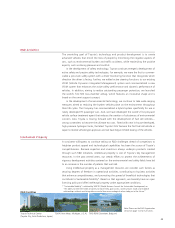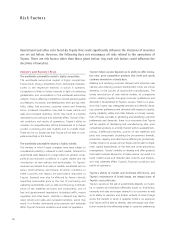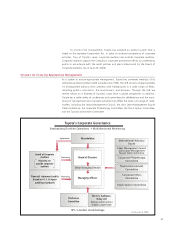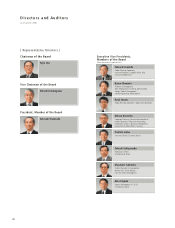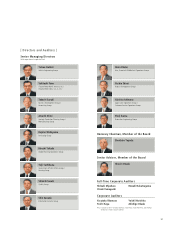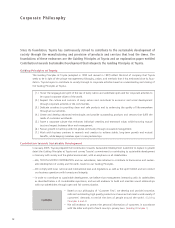Toyota 2006 Annual Report Download - page 45
Download and view the complete annual report
Please find page 45 of the 2006 Toyota annual report below. You can navigate through the pages in the report by either clicking on the pages listed below, or by using the keyword search tool below to find specific information within the annual report.
43
TEMA (Ann Arbor, Michigan, U.S.A.) TME-RDM (Zaventem, Belgium)Toyota Technical Center
(Toyota City, Aichi Prefecture, Japan)
R&D Activities
The overriding goal of Toyota’s technology and product development is to create
advanced vehicles that enrich the lives of people by minimizing the negative aspects of
cars, such as environmental burden and traffic accidents, while maximizing the positive
aspects, such as driving pleasure and comfort.
In the development of safety technology, Toyota continues energetic development of
active safety and passive safety technologies. For example, we were the first to commer-
cialize a pre-crash safety system with a driver monitoring function that recognizes which
direction the driver is facing. Further, we added active steering functions to our existing
VDIM (Vehicle Dynamics Integrated Management) system and commercialized a new
VDIM system that enhances the active safety performance and dynamic performance of
vehicles. In addition, aiming to realize outstanding passenger protection, we launched
the world’s first SRS two-chamber airbag, which features an innovative shape and is
based on the omni-support concept.
In the development of environmental technology, we continue to take wide-ranging
measures aimed at reducing the burden vehicles place on the environment throughout
their life cycles. The Company has commercialized a hybrid system specifically for use in
newly developed FR passenger cars. And, we have developed the world’s first pre-paint
vehicle surface treatment agent that reduces the creation of substances of environmental
concern. Also, Toyota is moving forward with the development of fuel cell vehicles—
strong contenders to become the ultimate eco cars. Fitted with new in-house-developed,
high-pressure hydrogen tanks, the latest Toyota FCHV became the first fuel cell vehicle in
Japan to receive vehicle-type approval, and we have begun limited leasing of the vehicles.
Intellectual Property
A consistent willingness to continue taking on R&D challenges ahead of competitors to
heighten product appeal and technological capabilities has been the source of Toyota’s
competitiveness. Because expertise and inventions always underpin products created
through such R&D initiatives, intellectual property is one of Toyota’s key management
resources. In the past several years, our steady efforts to protect the achievements of
vigorous development activities centered on the environmental and safety fields have led
to an increase in the number of patents that we hold.
Using intellectual property as a management resource, we consider such factors as
securing degrees of freedom in operational activities, contributing to business activities
that enhance competitiveness, and promoting the spread of beneficial technologies that
contribute to Sustainable Mobility*. Based on that approach, we basically have an open
licensing policy and offer intellectual property under appropriate conditions.
* “Sustainable Mobility” is defined by WBCSD (World Business Council for Sustainable Development) as
“the ability to meet the needs of society to move freely, gain access, communicate, trade, and establish
relationships without sacrificing other essential human or ecological values today or in the future.”
Note: Please see the R&D Organization
section on page 132 for full names.
R&D Facilities





